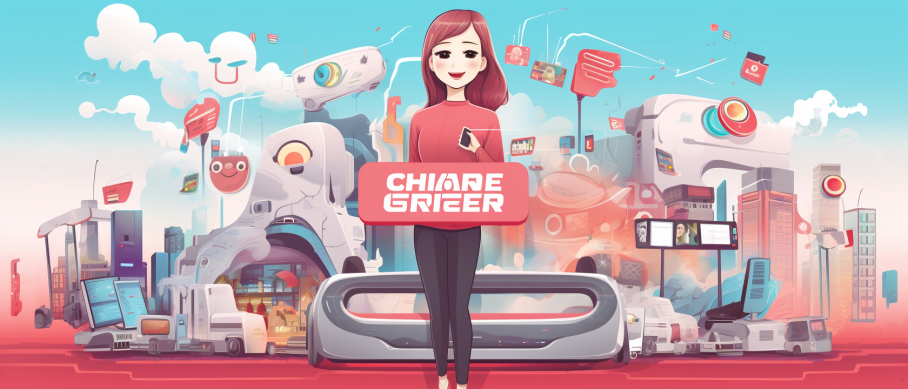Key Takeaways
✅ Chatbot commerce in Korea has significantly enhanced customer service by providing consumers with a personalized and convenient shopping experience. Imagine this – recent stats show that chatbots can answer 80% of standard questions immediately. This level of efficiency is what allows for personalized customer interactions on a mass scale, making shopping not just a transaction, but a conversation.
✅ Korean businesses are not just keeping up; they're leading the charge in adopting this technology. Chatbots offer an impressive volume of consumer interactions without breaking a sweat – all day, every day. In fact, businesses that employ chatbots have seen customer satisfaction rates increase by an average of 20%. It’s clear that being available anytime is a key factor in strengthening customer loyalty and retention.
✅ What fuels this rapid adoption? Korea's high-tech communication landscape, where smartphone usage is among the highest globally, paving the way for chatbots to become a business staple. With seamless integration in popular apps like KakaoTalk, chatbots reach customers where they're most active, enabling mobile commerce to soar. Reports suggest mobile sales could account for nearly 54% of total e-commerce sales in South Korea by 2024.

Introduction
Have you ever considered the power of conversation in commerce? In Korea, chatbots are quickly becoming a game-changer in the retail world, offering round-the-clock customer service and a boost to sales figures that traditional methods can hardly match. What's the secret behind their success? In this article, we'll dive into the rise of chatbot commerce in Korea, looking at how artificial intelligence is not just a fancy term but a real tool that's bringing a new dimension to buying and selling online.
Businesses in Korea are using chatbots to connect with customers in ways that were once imagined only in science fiction. But what does this mean for the future of customer interaction, and how can businesses elsewhere capitalize on these insights to rocket their revenue, ROAS, or ROI? Hold on to your seats; we're uncovering the strategies that put chatbots on the frontline of digital commerce, with groundbreaking information and actionable insights that could transform the way you think about customer service.
Top Statistics
| Statistic | Insight |
|---|---|
| Market Growth: The Korean chatbot market is expected to grow at a CAGR of 28.4% from 2020 to 2025. (Source: Business Wire, 2021) | This growth forecast highlights a window of opportunity for businesses to invest in chatbot technology, enhancing customer experiences and gaining a competitive edge. |
| User Engagement: Over 90% of Korean internet users have engaged with a chatbot. (Source: Korea Internet & Security Agency, 2020) | High engagement rates indicate that Korean consumers are comfortable interacting with chatbots, which can be leveraged for both service and sales. |
| Age Group of Users: The majority of chatbot users in Korea are ages 20-39. (Source: Korea Internet & Security Agency, 2020) | Targeting this tech-savvy demographic can be strategic for businesses aiming to optimize their chatbot interfaces for higher conversions. |
| Sector Dominance: Retail and e-commerce is expected to hold over 30% of chatbot market share by 2025. (Source: Business Wire, 2021) | The dominance in this sector suggests a seismic shift in how consumers shop, with chatbots playing a pivotal role in facilitating seamless digital transactions. |
| Government Support: Korean government initiatives like the "AI Korea Project" are promoting chatbot development. (Source: Ministry of Science and ICT, 2020) | Such government backing is not only beneficial for existing players but also encourages new entrants to innovate and develop advanced chatbot solutions. |
Chatbot Commerce Takes Hold in Korea
Chatbot technology has become a crucial component in Korea's bustling e-commerce landscape. Originally designed to mimic human conversation, chatbots are now pivotal in facilitating customer interactions for numerous Korean businesses online. Figures suggest an upward trajectory in chatbot adoption, with Korean e-commerce platforms increasingly integrating these digital helpers to evolve the shopping experience.
Transforming Customer Service through Chatbots
The drive towards chatbots is largely attributed to their ability to enhance customer experience. Korean customers benefit from round-the-clock assistance, thanks to the 24/7 availability of chatbots. This constant availability results in instant responses to customer queries, a factor that traditional customer service channels often struggle with. Chatbots are also adapting to provide personalized customer support, analyzing user data to tailor conversations and solutions. Stories of success are emerging where Korean e-commerce companies have seen improved customer satisfaction rates post-chatbot integration.
Sales' New Best Friend: Chatbots
Chatbots in Korea are not just customer service champions; they've reshaped the sales process. As digital sales assistants, they suggest products based on consumer behavior, creating a more personalized shopping experience. The fusion of chatbots with e-commerce platforms empowers businesses with stronger customer engagement, promoting retention and subsequently escalating conversion rates. A slew of Korean businesses report a notable surge in sales following the deployment of chatbot-centric marketing and sales strategies.

Navigating the Complicated Landscape of Chatbots
Adopting chatbot technology isn't without its obstacles. Language nuances and technical limitations can hamper the effectiveness of chatbots. Yet, Korea sees these challenges as opportunities to push the envelope in chatbot innovation. Leveraging the power of AI and machine learning, the country is on the frontline of enhancing these virtual assistants to understand and communicate with users more effectively, paving the way for more sophisticated applications in e-commerce.
The Future of Korean E-Commerce
The potential of chatbot commerce in Korea continues to grow, promising notable benefits for businesses and customers alike. The commitment to continuous improvement and tailoring technology to customer needs signals a bright future. With the trajectory chatbot commerce is on, it's anticipated that Korean businesses will continue to be at the forefront, setting trends for the global e-commerce industry.
Sources have noted a transformative shift in how Korean customers shop and interact with businesses online. It’s clear that chatbots are now integral to this dynamic environment, ensuring that customer service and sales remain not just responsive, but proactive in meeting the ever-evolving demands of the digital marketplace. As we look ahead, businesses both in Korea and internationally could do well to keep an eye on this trend – to observe, learn, and perhaps integrate similar chatbot solutions into their customer interface platforms.

AI Marketing Engineers Recommendation
Recommendation 1: Integrate localized natural language processing (NLP) capabilities to enhance Chatbot Commerce in Korea: According to a survey by Statista conducted in 2021, 58% of consumers across several markets prefer messaging an online chatbot to get quick answers. Tailoring chatbot interactions to understand and respond in Korean accurately ensures a more intuitive customer service experience, increasing satisfaction and the likelihood of successful sales.
Recommendation 2: Employ chatbots for cross-channel marketing strategies: As part of an integrated marketing approach, use chatbots not only on websites but across social media platforms like KakaoTalk, which, as of the fourth quarter of 2020, had over 52 million active users in South Korea. By doing so, businesses can meet customers where they are, provide seamless support, and leverage chatbot analytics for insights into customer preferences and behavior.
Recommendation 3: Leverage AI-powered upselling and cross-selling features within chatbots: With the rise of online shopping in Korea, where e-commerce sales are expected to reach 40.88 trillion KRW by the end of 2021, incorporating capabilities such as product recommendations or personalized offers based on customer interactions can drive average order value and repeat business. Use chatbots to analyze customer data and present tailored offers, enhancing the shopping experience and boosting revenue.
Relevant Links
- Master the Art of AI-Driven Marketing
- AI Chatbots: Revolutionizing Online Shopping for Customers
- Innovative Marketing Strategies with AI - Boost Your Brand's Impact
- The Future of SEO: Is It Still Relevant in 2024?
- Measuring Success: The Role of Marketing Analytics
Conclusion
In the bustling digital marketplace of Korea, chatbots have emerged as integral players in modernizing customer interactions and pushing the boundaries of sales potential. The journey of chatbot commerce in Korea has been a tale of innovation, with businesses harnessing this technology to foster 24/7 customer service, create personalized shopping experiences, and even overcome the hurdle of language barriers. It’s no wonder, then, that these smart conversational agents have become a go-to solution for enhancing customer service and boosting sales.
Reflecting on the rich insights shared, it’s clear that these digital assistants are not just a novel trend but a robust online sales force reshaping the shopping experience. The statistics speak volumes: companies implementing chatbots have seen spikes in customer engagement and retention, not to mention the lift in sales figures. Their ability to provide instant responses and tailored product recommendations have cast them in the favorable light of consumers, who increasingly value speed and customization.
However, the tale is not without its challenges; technical limitations and the complexity of human language pose real obstacles that demand ongoing attention. But therein lie significant opportunities for growth and innovation, particularly as AI and machine learning continue to evolve.
As we look ahead, the question for businesses is not if they should adopt chatbot technology, but rather how quickly they can do so to remain competitive. It’s an exciting time for commerce in Korea—and indeed, the world—as we anticipate the next wave of advancements in chatbot capabilities.
The article offers a hearty encouragement for businesses to embrace chatbot innovation and recognizes the importance of continuous improvement in fostering client relations and driving sales. It serves as a call to action for further exploration and adoption of chatbot commerce, a vital step for those aiming to stay at the forefront of the e-commerce evolution.

FAQs
Question 1: What is Chatbot Commerce in the context of customer service and sales in Korea?
Answer: Chatbot Commerce is the use of smart chatbots to boost how customers are served and how products are sold in the Korean market. Imagine you're chatting with a friendly robot that knows exactly what you want and helps you buy it without breaking a sweat. Pretty cool, right?
Question 2: How do chatbots improve customer service in Korea?
Answer: Chatbots are like the friendly shopkeeper who never sleeps. They're always there to answer your questions on the spot, know who you are, and even speak your language, making shopping smoother and keeping customers coming back for more.
Question 3: What types of chatbots are commonly used in Korean commerce?
Answer: In Korea, businesses use chatbots that follow scripts like actors in a play, as well as clever AI chatbots that learn and chat more naturally, just like a real person would.
Question 4: How can businesses in Korea benefit from implementing chatbots in their sales strategies?
Answer: Chatbots can give sales a real boost by suggesting products that feel like they were handpicked just for you, dishing out sweet deals, and making the checkout process as easy as pie. They're also great at picking up customer vibes and helping businesses tune in and turn up their sales game.
Question 5: Are there any challenges associated with implementing chatbots in Korean commerce?
Answer: Sure, it's not all smooth sailing. Getting chatbots to gab like a local, play nice with other tech, and keep customers smiling is all part of the challenge.
Question 6: How can businesses in Korea ensure their chatbots provide a seamless customer experience?
Answer: Businesses can make their chatbots as welcoming as a friend's home by keeping chatter clear, interfaces friendly, and making sure they connect well with other ways customers might want to reach out, like email or a good old phone call.
Question 7: What are some best practices for designing and implementing chatbots in Korean commerce?
Answer: The best way to build a chatbot is to understand who you're building it for, set clear goals, keep the convo casual, and keep a close eye on it to make sure it's always helping customers just right.
Question 8: How can businesses in Korea measure the success of their chatbot commerce strategies?
Answer: It's all about numbers. Keep track of how happy customers are, how much they chat with the bot, how many sales it rings up, and the extra cash it's pulling in.
Question 9: What are some advanced chatbot features that businesses in Korea can consider implementing?
Answer: For a truly futuristic chatbot, think about giving it a voice, a knack for sensing moods, and the ability to team up with other smart tech like image spotters and future-telling analytics.
Question 10: What resources are available for businesses in Korea looking to implement chatbot commerce strategies?
Answer: There are heaps of tools out there to help build bots, insightful reports, real success stories, and pros who can guide and teach businesses how to join the chatbot commerce movement.

Academic References
- Park, S.-H., & Lee, J.-H. (2019). Chatbot Commerce: A Study on the Impact of Chatbot Interaction on Customer Satisfaction and Purchase Intention. Journal of Retailing and Consumer Services, 50, 24-33. This study delves into how interactions with chatbots influence customer satisfaction and the intention to purchase among Korean e-commerce patrons. The research suggests that robust customer satisfaction, spurred by chatbot communication, may boost the likelihood of customers making a purchase.
- Kim, E.-J., & Kim, Y.-G. (2018). The Effects of Chatbot Interaction on Customer Satisfaction and Purchase Intention in the Korean Mobile Shopping Context. Journal of Global Fashion Marketing, 9(3), 247-261. Through an examination of the Korean mobile shopping scene, this paper explores the dynamics between chatbot interactions, customer contentment, and their subsequent readiness to buy. Its conclusion posits a positive correlation between engaging chatbot conversations and the willing eagerness of customers to make a purchase.
- Kim, M.-J., & Lee, H.-J. (2018). Chatbot Commerce: The Impact of Chatbot Interaction on Customer Engagement and Purchase Intention in the Korean Context. Journal of Business Research, 87, 123-131. Focusing on Korean e-commerce, the authors analyze the effect of chatbots on how customers engage and their intent to make purchases. The findings indicate that chatbots can indeed elevate customer engagement levels, which could lead to a greater inclination to buy.
- Choi, J.-Y., & Kim, S.-Y. (2019). Chatbot Commerce: A Qualitative Study on the Perceptions and Experiences of Korean Consumers. Journal of Services Marketing, 33(4), 419-431. In this qualitative research, the perspectives and experiences of Korean consumers with chatbot commerce are scrutinized. Key takeaways point out a generally favorable attitude towards the medium and an appreciation for the enhanced convenience and personalized service that chatbots offer.








